Paper Menu >>
Journal Menu >>
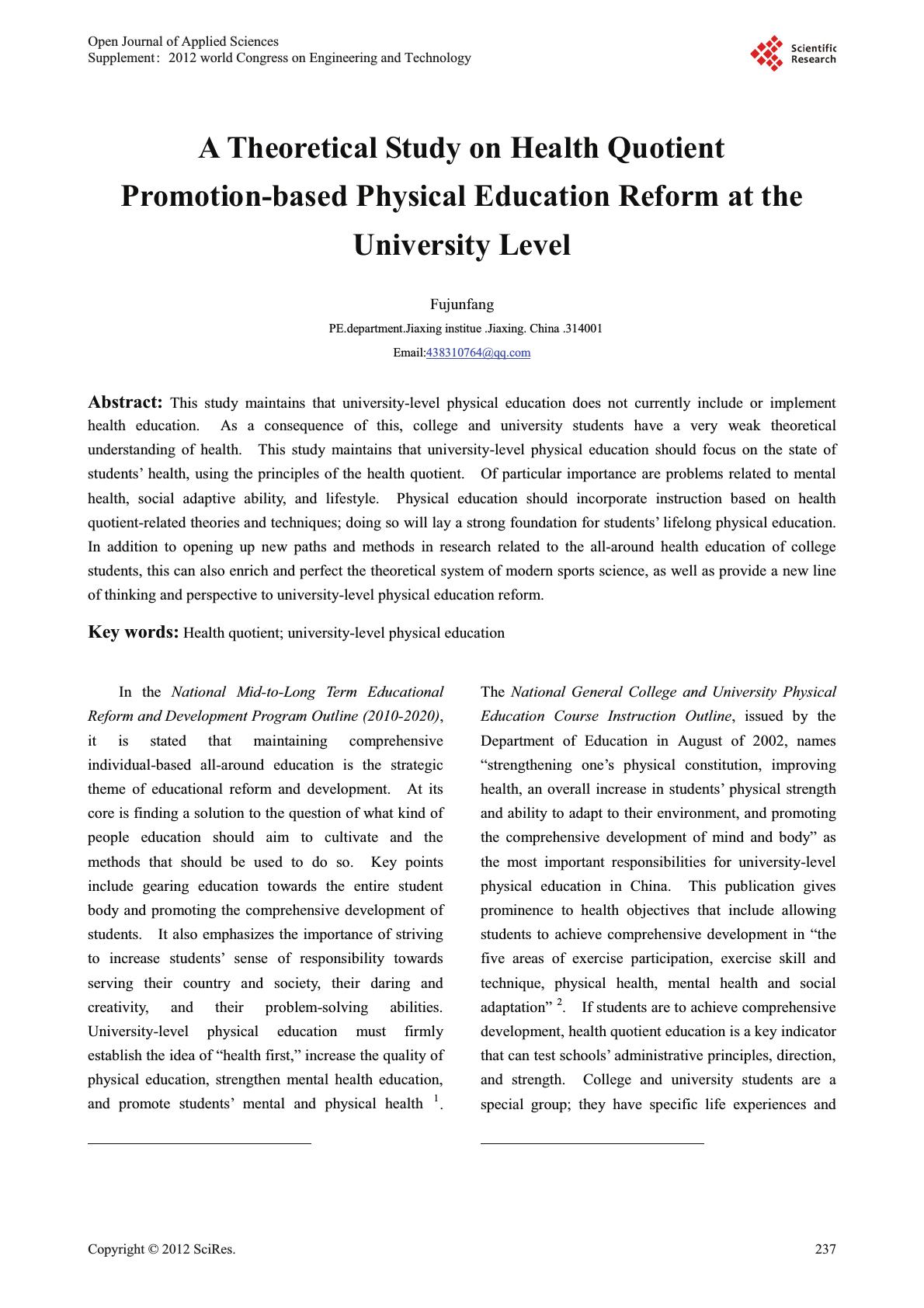 ATheoreticalStudy on Health Quotient Promotion-based Physical Education Reform at the University Level Fujunfang PE.department.Jiaxing institue .Jiaxing. China .314001 Email:438310764@qq.com Abstract: This study maintains that university-level physical education does not currently include or implement health education. As a consequence of this, college and university students have a very weak theoretical understanding of health. This study maintains that university-level physical education should focus on the state of students’ health, using the principles of the health quotient. Of particular importance are problems related to mental health, social adaptive ability, and lifestyle. Physical education should incorporate instruction based on health quotient-related theories and techniques; doing so will lay a strong foundation for students’ lifelong physical education. In addition to opening up new paths and methods in research related to the all-around health education of college students, this can also enrich and perfect the theoretical system of modern sports science, as well as provide a new line of thinking and perspective to university-level physical education reform. Key words:Health quotient; university-level physical education In the National Mid-to-Long Term Educational Reform and Development Program Outline (2010-2020), it is stated that maintaining comprehensive individual-based all-around education is the strategic theme of educational reform and development. At its core is finding a solution to the question of what kind of people education should aim to cultivate and the methods that should be used to do so. Key points include gearing education towards the entire student body and promoting the comprehensive development of students. It also emphasizes the importance of striving to increase students’ sense of responsibility towards serving their country and society, their daring and creativity, and their problem-solving abilities. University-level physical education must firmly establish the idea of “health first,” increase the quality of physical education, strengthen mental health education, and promote students’ mental and physical health 1. The National General College and University Physical Education Course Instruction Outline, issued by the Department of Education in August of 2002, names “strengthening one’s physical constitution, improving health, an overall increase in students’ physical strength and ability to adapt to their environment, and promoting the comprehensive development of mind and body” as the most important responsibilities for university-level physical education in China. This publication gives prominence to health objectives that include allowing students to achieve comprehensive development in “the five areas of exercise participation, exercise skill and technique, physical health, mental health and social adaptation” 2. If students are to achieve comprehensive development, health quotient education is a key indicator that can test schools’ administrative principles, direction, and strength. College and university students are a special group; they have specific life experiences and Open Journal of Applied Sciences Supplement:2012 world Congress on Engineering and Technology Cop y ri g ht © 2012 SciRes.237 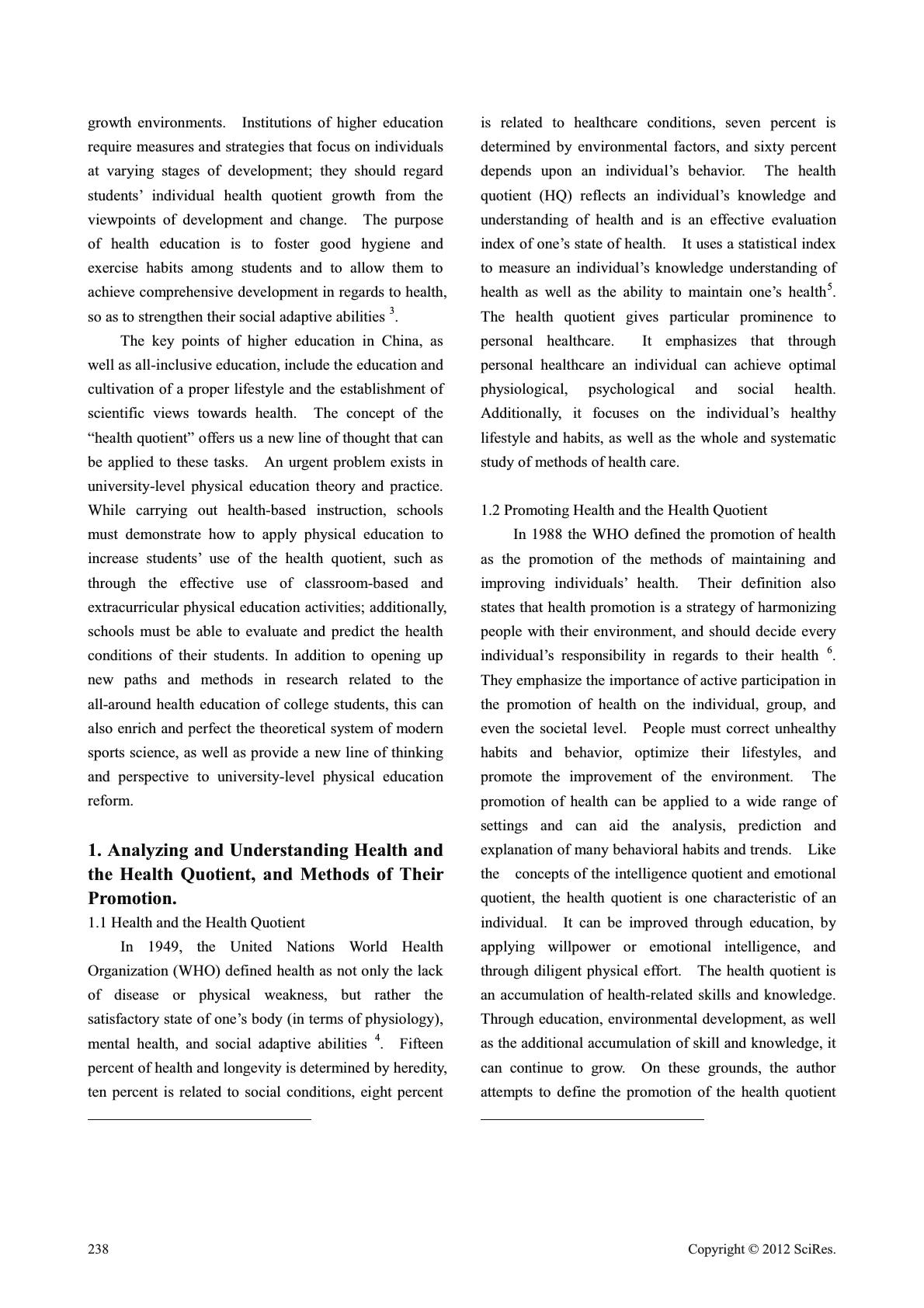 growth environments. Institutions of higher education require measures and strategies that focus on individuals at varying stages of development; they should regard students’ individual health quotient growth from the viewpoints of development and change. The purpose of health education is to foster good hygiene and exercise habits among students and to allow them to achieve comprehensive development in regards to health, so as to strengthen their social adaptive abilities 3 In 1949, the United Nations World Health Organization (WHO) defined health as not only the lack of disease or physical weakness, but rather the satisfactory state of one’s body (in terms of physiology), mental health, and social adaptive abilities . The key points of higher education in China, as well as all-inclusive education, include the education and cultivation of a proper lifestyle and the establishment of scientific views towards health. The concept of the “health quotient” offers us a new line of thought that can be applied to these tasks. An urgent problem exists in university-level physical education theory and practice. While carrying out health-based instruction, schools must demonstrate how to apply physical education to increase students’ use of the health quotient, such as through the effective use of classroom-based and extracurricular physical education activities; additionally, schools must be able to evaluate and predict the health conditions of their students. In addition to opening up new paths and methods in research related to the all-around health education of college students, this can also enrich and perfect the theoretical system of modern sports science, as well as provide a new line of thinking and perspective to university-level physical education reform. 1. Analyzing and Understanding Health and the Health Quotient, and Methods of Their Promotion. 1.1 Health and the Health Quotient 4. Fifteen percent of health and longevity is determined by heredity, ten percent is related to social conditions, eight percent is related to healthcare conditions, seven percent is determined by environmental factors, and sixty percent depends upon an individual’s behavior. The health quotient (HQ) reflects an individual’s knowledge and understanding of health and is an effective evaluation index of one’s state of health. It uses a statistical index to measure an individual’s knowledge understanding of health as well as the ability to maintain one’s health5 In 1988 the WHO defined the promotion of health as the promotion of the methods of maintaining and improving individuals’ health. Their definition also states that health promotion is a strategy of harmonizing people with their environment, and should decide every individual’s responsibility in regards to their health . The health quotient gives particular prominence to personal healthcare. It emphasizes that through personal healthcare an individual can achieve optimal physiological, psychological and social health. Additionally, it focuses on the individual’s healthy lifestyle and habits, as well as the whole and systematic study of methods of health care. 1.2 Promoting Health and the Health Quotient 6. They emphasize the importance of active participation in the promotion of health on the individual, group, and even the societal level. People must correct unhealthy habits and behavior, optimize their lifestyles, and promote the improvement of the environment.The promotion of health can be applied to a wide range of settings and can aid the analysis, prediction and explanation of many behavioral habits and trends. Like the concepts of the intelligence quotient and emotional quotient, the health quotient is one characteristic of an individual. It can be improved through education, by applying willpower or emotional intelligence, and through diligent physical effort. The health quotient is an accumulation of health-related skills and knowledge. Through education, environmental development, as well as the additional accumulation of skill and knowledge, it can continue to grow. On these grounds, the author attempts to define the promotion of the health quotient 238 Cop y ri g ht © 2012 SciRes. 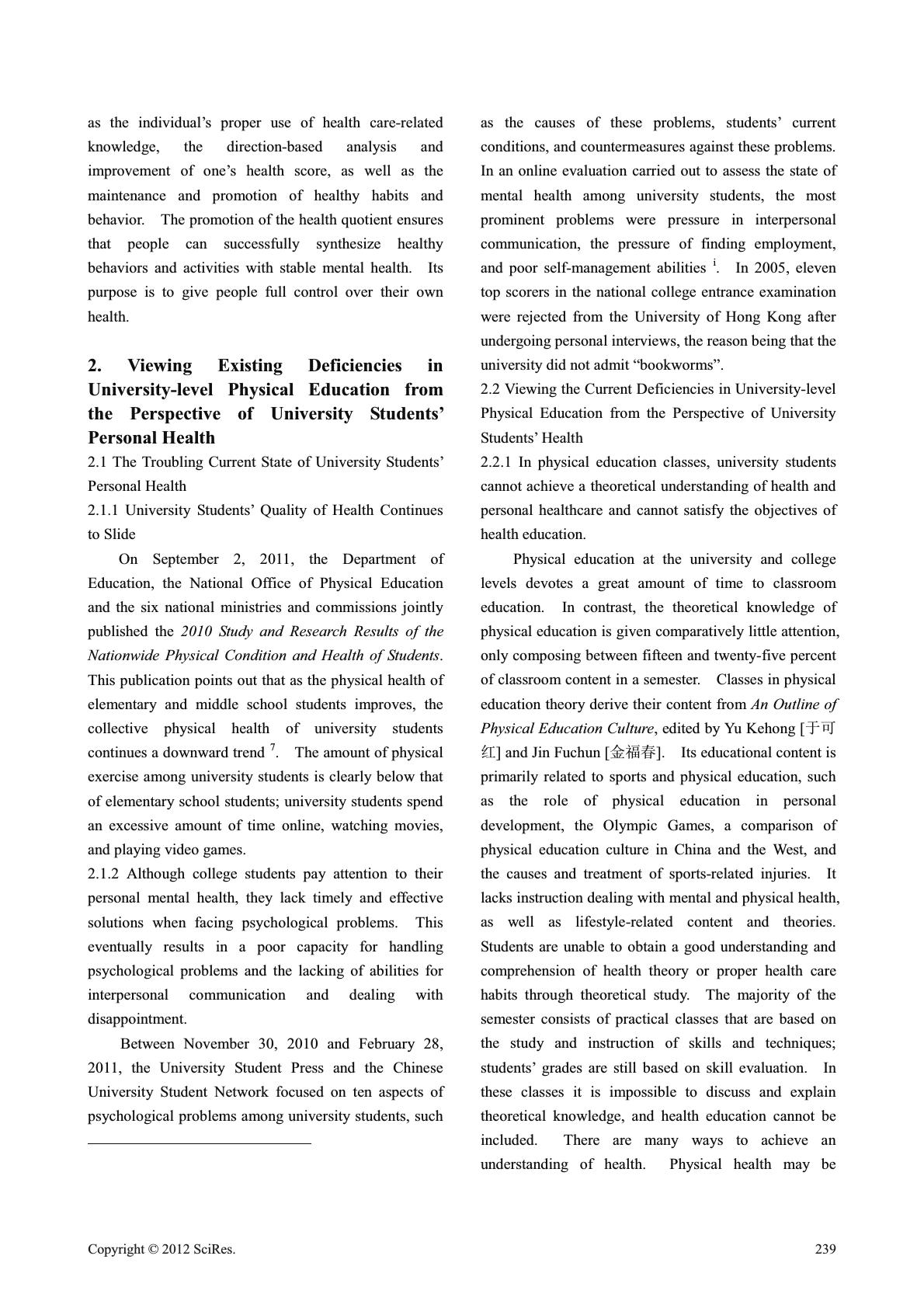 as the individual’s proper use of health care-related knowledge, the direction-based analysis and improvement of one’s health score, as well as the maintenance and promotion of healthy habits and behavior. The promotion of the health quotient ensures that people can successfully synthesize healthy behaviors and activities with stable mental health. Its purpose is to give people full control over their own health. 2. Viewing Existing Deficiencies in University-level Physical Education from the Perspective of University Students’ Personal Health 2.1 The Troubling Current State of University Students’ Personal Health 2.1.1 University Students’ Quality of Health Continues to Slide On September 2, 2011, the Department of Education, the National Office of Physical Education and the six national ministries and commissions jointly published the 2010 Study and Research Results of the Nationwide Physical Condition and Health of Students. This publication points out that as the physical health of elementary and middle school students improves, the collective physical health of university students continues a downward trend 7 Between November 30, 2010 and February 28, 2011, the University Student Press and the Chinese University Student Network focused on ten aspects of psychological problems among university students, such . The amount of physical exercise among university students is clearly below that of elementary school students; university students spend an excessive amount of time online, watching movies, and playing video games. 2.1.2 Although college students pay attention to their personal mental health, they lack timely and effective solutions when facing psychological problems. This eventually results in a poor capacity for handling psychological problems and the lacking of abilities for interpersonal communication and dealing with disappointment. as the causes of these problems, students’ current conditions, and countermeasures against these problems. In an online evaluation carried out to assess the state of mental health among university students, the most prominent problems were pressure in interpersonal communication, the pressure of finding employment, and poor self-management abilities i 2.2 Viewing the Current Deficiencies in University-level Physical Education from the Perspective of University Students’ Health . In 2005, eleven top scorers in the national college entrance examination were rejected from the University of Hong Kong after undergoing personal interviews, the reason being that the university did not admit “bookworms”. 2.2.1 In physical education classes, university students cannot achieve a theoretical understanding of health and personal healthcare and cannot satisfy the objectives of health education. Physical education at the university and college levels devotes a great amount of time to classroom education. In contrast, the theoretical knowledge of physical education is given comparatively little attention, only composing between fifteen and twenty-five percent of classroom content in a semester. Classes in physical education theory derive their content from An Outline of Physical Education Culture, edited by Yu Kehong [Ҿਟ 㓒] and Jin Fuchun [䠁⾿᱕]. Its educational content is primarily related to sports and physical education, such as the role of physical education in personal development, the Olympic Games, a comparison of physical education culture in China and the West, and the causes and treatment of sports-related injuries. It lacks instruction dealing with mental and physical health, as well as lifestyle-related content and theories. Students are unable to obtain a good understanding and comprehension of health theory or proper health care habits through theoretical study. The majority of the semester consists of practical classes that are based on the study and instruction of skills and techniques; students’ grades are still based on skill evaluation. In these classes it is impossible to discuss and explain theoretical knowledge, and health education cannot be included. There are many ways to achieve an understanding of health. Physical health may be Cop y ri g ht © 2012 SciRes.239 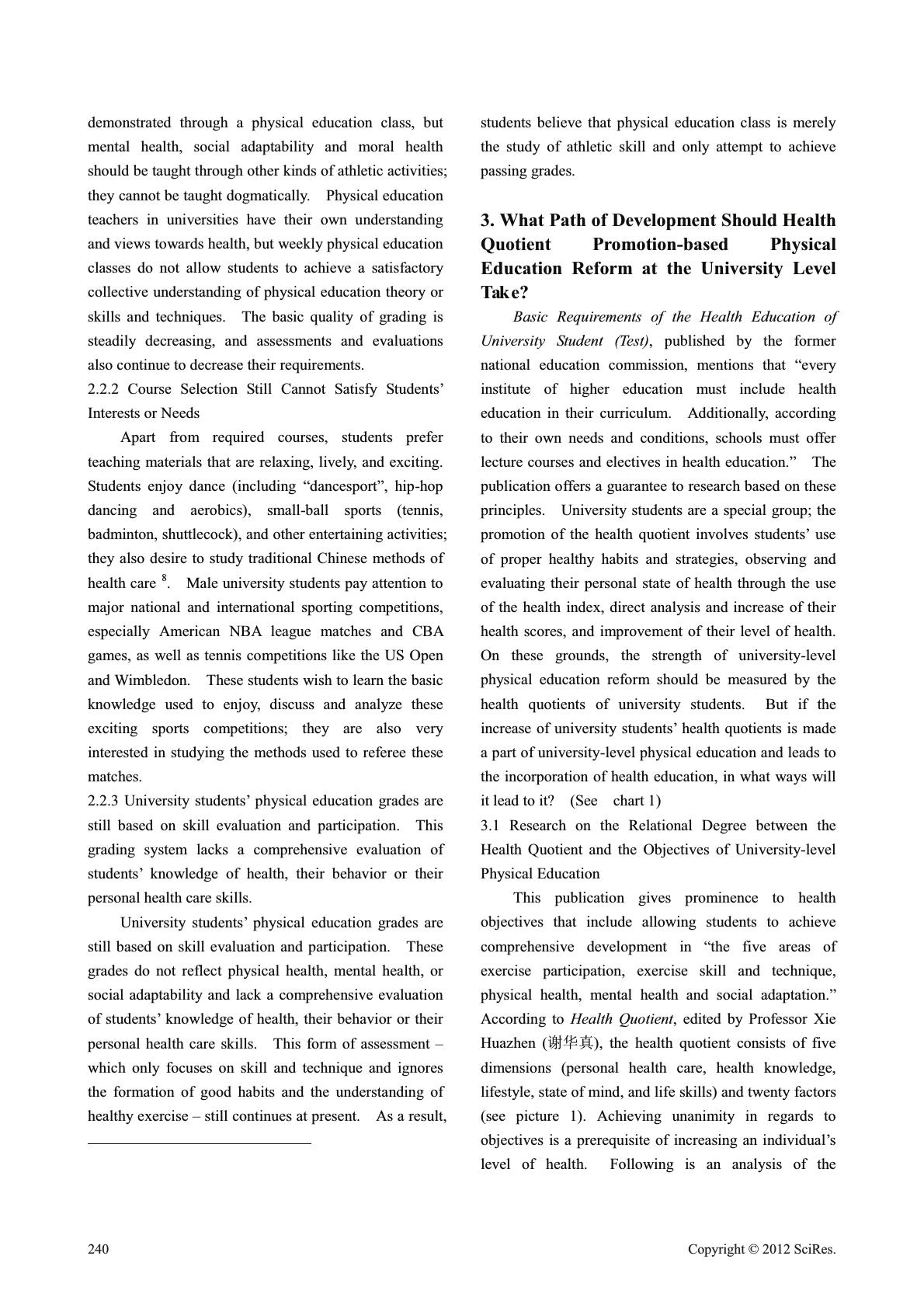 demonstrated through a physical education class, but mental health, social adaptability and moral health should be taught through other kinds of athletic activities; they cannot be taught dogmatically. Physical education teachers in universities have their own understanding and views towards health, but weekly physical education classes do not allow students to achieve a satisfactory collective understanding of physical education theory or skills and techniques. The basic quality of grading is steadily decreasing, and assessments and evaluations also continue to decrease their requirements. 2.2.2 Course Selection Still Cannot Satisfy Students’ Interests or Needs Apart from required courses, students prefer teaching materials that are relaxing, lively, and exciting. Students enjoy dance (including “dancesport”, hip-hop dancing and aerobics), small-ball sports (tennis, badminton, shuttlecock), and other entertaining activities; they also desire to study traditional Chinese methods of health care 8 University students’ physical education grades are still based on skill evaluation and participation. These grades do not reflect physical health, mental health, or social adaptability and lack a comprehensive evaluation of students’ knowledge of health, their behavior or their personal health care skills. This form of assessment – which only focuses on skill and technique and ignores the formation of good habits and the understanding of healthy exercise – still continues at present. As a result, . Male university students pay attention to major national and international sporting competitions, especially American NBA league matches and CBA games, as well as tennis competitions like the US Open and Wimbledon. These students wish to learn the basic knowledge used to enjoy, discuss and analyze these exciting sports competitions; they are also very interested in studying the methods used to referee these matches. 2.2.3 University students’ physical education grades are still based on skill evaluation and participation. This grading system lacks a comprehensive evaluation of students’ knowledge of health, their behavior or their personal health care skills. students believe that physical education class is merely the study of athletic skill and only attempt to achieve passing grades. 3. What Path of Development Should Health Quotient Promotion-based Physical Education Reform at the University Level Tak e? Basic Requirements of the Health Education of University Student (Test), published by the former national education commission, mentions that “every institute of higher education must include health education in their curriculum. Additionally, according to their own needs and conditions, schools must offer lecture courses and electives in health education.” The publication offers a guarantee to research based on these principles. University students are a special group; the promotion of the health quotient involves students’ use of proper healthy habits and strategies, observing and evaluating their personal state of health through the use of the health index, direct analysis and increase of their health scores, and improvement of their level of health. On these grounds, the strength of university-level physical education reform should be measured by the health quotients of university students. But if the increase of university students’ health quotients is made a part of university-level physical education and leads to the incorporation of health education, in what ways will it lead to it? (See chart 1) 3.1 Research on the Relational Degree between the Health Quotient and the Objectives of University-level Physical Education This publication gives prominence to health objectives that include allowing students to achieve comprehensive development in “the five areas of exercise participation, exercise skill and technique, physical health, mental health and social adaptation.” According to Health Quotient, edited by Professor Xie Huazhen (䉒ॾⵏ), the health quotient consists of five dimensions (personal health care, health knowledge, lifestyle, state of mind, and life skills) and twenty factors (see picture 1). Achieving unanimity in regards to objectives is a prerequisite of increasing an individual’s level of health. Following is an analysis of the 240 Cop y ri g ht © 2012 SciRes. 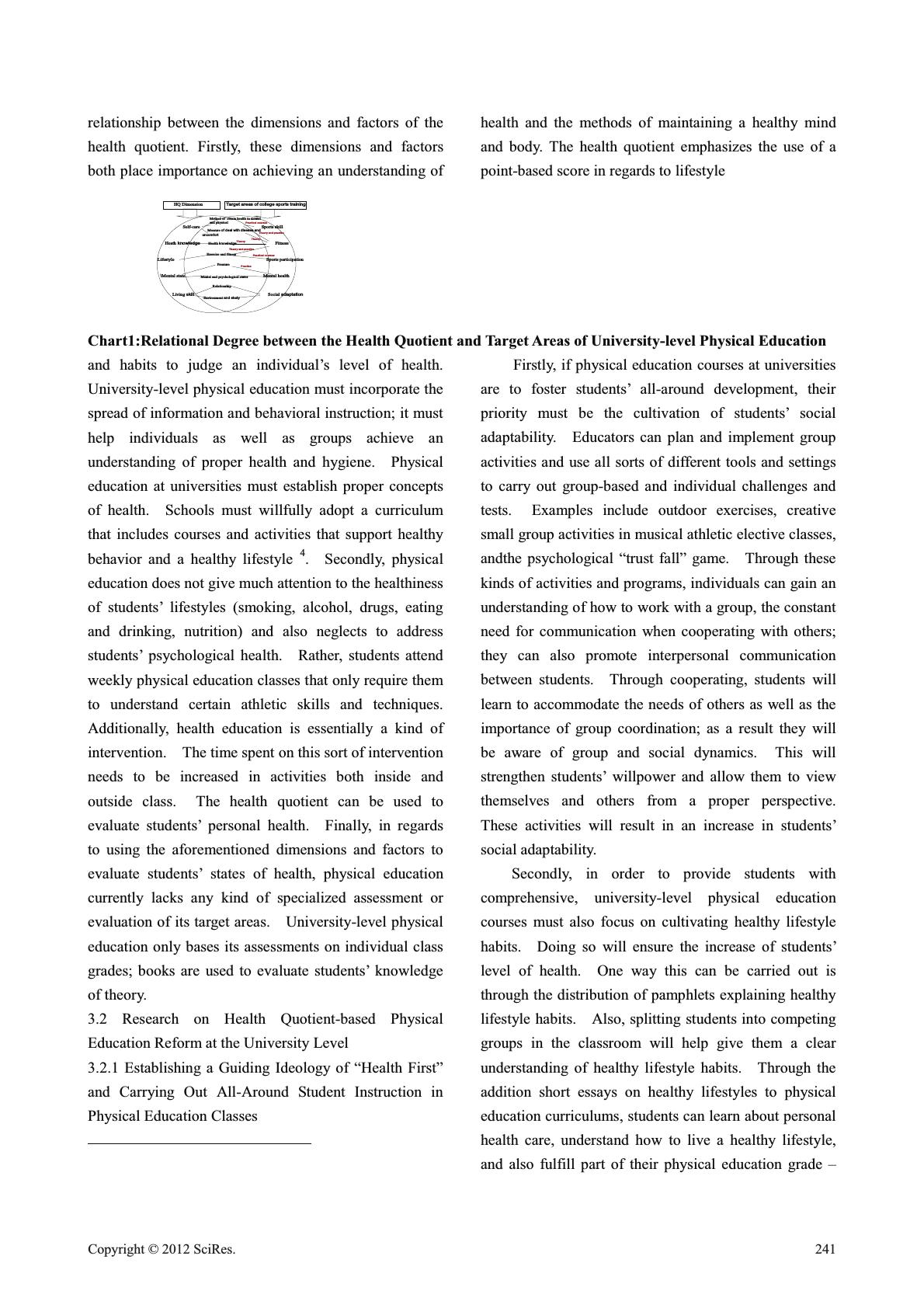 relationship between the dimensions and factors of the health quotient. Firstly, these dimensions and factors both place importance on achieving an understanding of health and the methods of maintaining a healthy mind and body. The health quotient emphasizes the use of a point-based score in regards to lifestyle Lifestyle Sports participation Self-care Sports skill Heath knowledge Fitness \Mental state Mental health Living skill Social adaptation Target areas of college sports training Method of obtain health in mental and physical Measure of deal with disease and uncomfort Health knowledge Exercise and fitness Pressure Practical courses Theory and practise Theory Theory Mental and psychological states Relationship Environment and study Theory and practise Practical courses Practise HQ Dimension Chart1:Relational Degree between the Health Quotient and Target Areas of University-level Physical Education and habits to judge an individual’s level of health. University-level physical education must incorporate the spread of information and behavioral instruction; it must help individuals as well as groups achieve an understanding of proper health and hygiene. Physical education at universities must establish proper concepts of health. Schools must willfully adopt a curriculum that includes courses and activities that support healthy behavior and a healthy lifestyle 4. Secondly, physical education does not give much attention to the healthiness of students’ lifestyles (smoking, alcohol, drugs, eating and drinking, nutrition) and also neglects to address students’ psychological health. Rather, students attend weekly physical education classes that only require them to understand certain athletic skills and techniques. Additionally, health education is essentially a kind of intervention. The time spent on this sort of intervention needs to be increased in activities both inside and outside class. The health quotient can be used to evaluate students’ personal health. Finally, in regards to using the aforementioned dimensions and factors to evaluate students’ states of health, physical education currently lacks any kind of specialized assessment or evaluation of its target areas. University-level physical education only bases its assessments on individual class grades; books are used to evaluate students’ knowledge of theory. 3.2 Research on Health Quotient-based Physical Education Reform at the University Level 3.2.1 Establishing a Guiding Ideology of “Health First” and Carrying Out All-Around Student Instruction in Physical Education Classes Firstly, if physical education courses at universities are to foster students’ all-around development, their priority must be the cultivation of students’ social adaptability. Educators can plan and implement group activities and use all sorts of different tools and settings to carry out group-based and individual challenges and tests. Examples include outdoor exercises, creative small group activities in musical athletic elective classes, andthe psychological “trust fall” game. Through these kinds of activities and programs, individuals can gain an understanding of how to work with a group, the constant need for communication when cooperating with others; they can also promote interpersonal communication between students. Through cooperating, students will learn to accommodate the needs of others as well as the importance of group coordination; as a result they will be aware of group and social dynamics. This will strengthen students’ willpower and allow them to view themselves and others from a proper perspective. These activities will result in an increase in students’ social adaptability. Secondly, in order to provide students with comprehensive, university-level physical education courses must also focus on cultivating healthy lifestyle habits. Doing so will ensure the increase of students’ level of health. One way this can be carried out is through the distribution of pamphlets explaining healthy lifestyle habits. Also, splitting students into competing groups in the classroom will help give them a clear understanding of healthy lifestyle habits. Through the addition short essays on healthy lifestyles to physical education curriculums, students can learnabout personal health care, understand how to live a healthy lifestyle, and also fulfill part of their physical education grade – Cop y ri g ht © 2012 SciRes.241  how can one argue against implementing this? 3.2.2 The Content of University-level Physical Education Must Be Expanded Classes on theory must include content on health-quotient education, particularly in respect to lifestyle, personal health care and healing. Practical classes should incorporate group-building activities. For instance, according to the respective needs of physical education programs, schools should add group-based practices and competitions that increase group awareness and collective competition. Such activities include group competitions in the form of large-ball games like basketball, volleyball and football. These competitions may be carried out between teams or even amongst different classes. These do not need to utilize a full court for these activities; many places may be used for small-scale activities. Students may freely organize teams for small-ball sports (table tennis, badminton, tennis); Shooting games may also be carried out. Activities with musical accompaniment (aerobics, hip-hop dancing, rhythmic exercises) can even test students’ ability to create routines. 3.2.3 More time must be devoted to theoretical study in class. Students must improve their understanding of health and health care and should learn how to determine their own state of physical health. Classes on theory must be increased. Content taught in technique-based classes must be flexible and direct enough to incorporate instruction and perspectives related to the health quotient. Some students take a greater interest in learning about rather prominent health problems. Classes may provide a daily log for students; through constant attention, teachers may provide assistance to students or coordinate with other professional instructors to directly correct and maintain healthy behavior and habits. 3.2.4 Increasing the overall quality of university physical education instructors; carrying out a comprehensive evaluation of the objectives of physical education courses– physical health, mental health and social adaptability. Physical education instructors must not only possess athletic knowledge and skill but should also have an abundant knowledge of healthand health care. In addition to evaluating students’ physical abilities, they must be able to carry out the comprehensive analysis of the physical education course objectives of physical health, mental health and social adaptability. 3.2.5 University-level physical education must include health quotient-based education in its scope of evaluation. Self-evaluation should be combined with the evaluation of students, not simply students’ evaluation of their instructors. 242 Cop y ri g ht © 2012 SciRes. |

